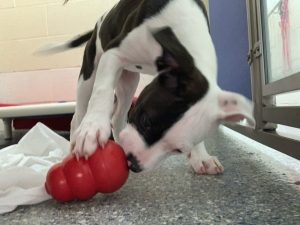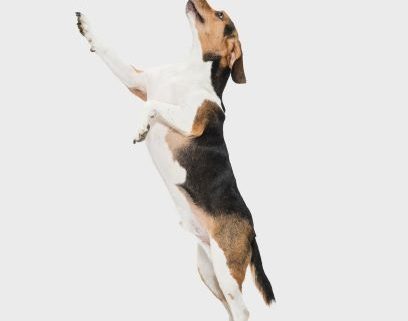Ask Crystal: Excited Greeter
 Dear Crystal,
Dear Crystal,
How can I get my dog to stop barking and jumping on me before I go out the door and when I come home?
Sincerely,
Excited Greeter
Dear Excited,
Excited greetings are an extremely common problem for the majority of dog owners. Dogs love to jump up to greet us. That is where the smelliest part is. Your mouth! We should first look at the reasons why dogs behave this way and then we can approach making a plan to change that behavior to something more acceptable.
First, let’s make sure that the dog’s needs have been met. A big part of over excitement is an excess of energy. Make a plan for incorporating exercise and enrichment into your dog’s daily life. Figure out what your dog likes to do for exercise and try to fit 2 or 3 exercise sessions into his day. That could be a fetch session, tug, flirt pole, or decompression walk. You can also incorporate games like nose work and other training games to help tire him out. Feed exclusively through enrichment feeding toys to help burn mental energy and help with boredom. I would hazard a guess that having a little less energy might be a good thing for this pup.
Next, let’s talk about what attention means to a dog. Attention to a dog is being looked at, talked to or touched. The context doesn’t matter. If you yell, “no”, while looking at your dog and pushing him off, he just got all three forms of attention. It doesn’t matter that you were upset when you said them. It’s not dissimilar to the kid that acts out in order to get sent to the principal’s office. Sometimes negative attention is better than no attention at all. And some dogs only seem to get attention when they are misbehaving.
It sounds like your dog is free roaming the house when you leave rather than staying in a crate. If you don’t like using crates, I would suggest that you consider a baby gate or a pen that can block your dog’s access to the door that you walk into when you come home. You can still give your dog a lot of room to roam around without having the dog being able to reach you when you get in the door.
 When you are preparing to leave, put the dog behind the gate so that when you come home he will not be able to reach you. Leave a frozen kong or bone stuffed with canned food, cream cheese, bananas or other dog safe food when you leave to give him something to do and a more positive association with your leaving. You may find that he is so busy with eating his bone, he doesn’t notice that you are leaving.
When you are preparing to leave, put the dog behind the gate so that when you come home he will not be able to reach you. Leave a frozen kong or bone stuffed with canned food, cream cheese, bananas or other dog safe food when you leave to give him something to do and a more positive association with your leaving. You may find that he is so busy with eating his bone, he doesn’t notice that you are leaving.
When you come home, if you hear the dog barking from outside the door, wait until he stops to come inside the door. Enter the house calmly without saying anything. Wait for him to be quiet and calm before greeting. In the beginning, understand that you have to take what small positive behavior you can get. Maybe the dog is quiet for a couple seconds at first. Take what you can get for now. If you can’t find anything to reinforce then you can’t teach the dog anything. Later when he starts to get the idea, we can slowly start increasing the amount of time he needs to be quiet before we greet him. If he starts barking, say “oops” and keeping ignoring and going about your business.
Another fun idea to redirect your dog’s energy is to play a game with him when you come home. Stash a box of favorite toys outside the door. When you come in the door, wait for the dog to sit and toss his toy for him. If he is too excited to sit, start by waiting for four on the floor and work up to waiting for a sit. This game is a great way to redirect your dog’s excitement and energy when you come home. Teach your children and visitors as well.
The way I like to frame things is instead of thinking about what you don’t want your dog to be doing, think about what you do want it to be doing. It is easier to teach an alternative behavior to the jumping rather than teaching an absence of a behavior. Teaching a sit for greeting can be a really nice polite behavior for a dog that wants to be greeted. Depending on the dog, it may be a lot to ask in the beginning so we may have to start with some easier behaviors like having all four feet on the floor.
A good way to teach this behavior is to put the dog on a tether which you can attach to a heavy piece of furniture, close it in a door. Approach the dog and stop, if the dog looks like he is about to jump up, turn and walk away. If he keeps all four feet on the floor, say “yes” and feed a treat and walk away. Repeat many times. Many dogs will resume jumping up as soon as you feed the treat, especially if they have been reinforced for that behavior before. If he does, just turn and walk away and approach again.
 If the dog knows how to sit, the next step would be waiting for the dog to sit when you approach, say “yes” and then feed a treat. Rather than telling the dog to sit, we want the dog to offer the behavior on his own. This way we teach the dog the cue to sit is when someone approaches so it will become an automatic behavior. If he is really struggling, you may cue it a few times to give him a hint and then go back to waiting for him to sit.
If the dog knows how to sit, the next step would be waiting for the dog to sit when you approach, say “yes” and then feed a treat. Rather than telling the dog to sit, we want the dog to offer the behavior on his own. This way we teach the dog the cue to sit is when someone approaches so it will become an automatic behavior. If he is really struggling, you may cue it a few times to give him a hint and then go back to waiting for him to sit.
As the dog gets better at sitting when approached, you can start to increase the duration that you wait before you offer a treat. At first, we treat as soon as the dog sits but as they get better wait a few seconds before saying, “yes” and treating. When the dog can calmly sit for 10 seconds, you may consider adding a touch or a pet while feeding a treat. Touching can often get the dog excited so it is best to work that distraction in at the end as the dog is really starting to get the behavior.
Practice this training with everyone in the house. Once the dog has gotten it with family members, see if you can recruit any friends to come over and help. You will probably need to give the dog time to calm down before attempting this. Explain the rules of the game to your friends and coach them as they go along.
Make a plan for when guests come over. We don’t want the dog to be practicing this behavior with guests and some guests are not going to want to play your training game or they may be unable or unwilling to follow directions. You may want to have him on a tether when they arrive. This will allow him time to see the guests come in but not be able to jump on them. If they want to participate in training, you can hand them some treats for when he calms down. Some dogs do well behind a baby gate when guests come over. If he is crate trained, you can always have him in a crate until he calms down and then walk him out on a leash.
I can’t tell you how many times I have knocked on a client’s door to be greeted by a dog jumping up on me. There is absolutely nothing wrong with either leaving a note on the door explaining that you need to put your dog away or simply saying to the person, “Give me just a minute, I need to put my dog away.” I think they will appreciate being able to walk into your house without getting tackled.
If a dog is having a lot of trouble with excitement barking or frustration barking, consider using a positive interrupter. A positive interrupter is a word or sound that you say and your dog will stop what he is doing and come over to you so you can redirect him into something else. We teach this by using classical conditioning to create an association of the word or sound with food. This is preferable to getting upset and yelling at the dog which doesn’t inform what he should be doing and often can make barking worse. This way we can keep things positive and redirect the dog to a more appropriate behavior.
Start by training this inside the house. Say your chosen positive interrupter word, then mark it with a “yes” and feed a treat. Repeat many times. The dog doesn’t need to do anything, we are just creating an association between the word and food. Once your dog’s ears start to perk up when hearing the positive interrupter, you know he is starting to get the association. Then you can start practicing when the dog is distracted. When he is mildly interested in something, say the word, yes and when he comes over to you feed him the treat. Eventually, you can say this word any time that you need the dog to stop doing something and to come over to you.
I know it is frustrating but also how great is it that we have animals that love us that much to be so excited when we come home. Be patient, set your dog up for success and be consistent and you will hopefully start to see some improvement. As always, consider reaching out to schedule an appointment with a Certified Professional Dog Trainer if you still need help. Locate one here. Good luck and happy training.
Until next time,
Crystal







